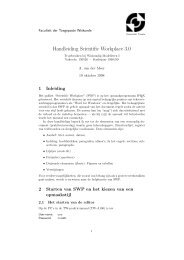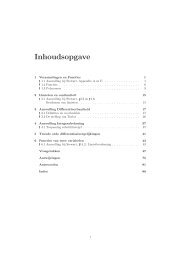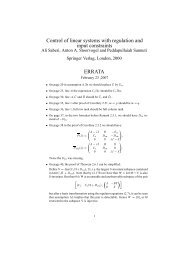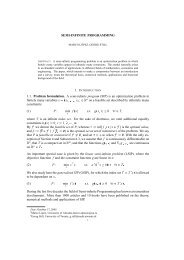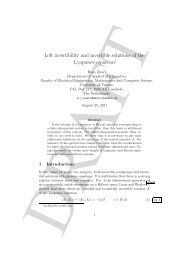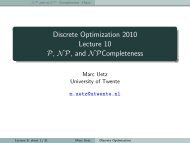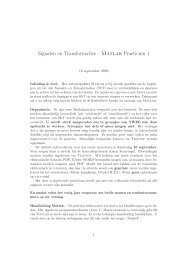Lecture Notes Discrete Optimization - Applied Mathematics
Lecture Notes Discrete Optimization - Applied Mathematics
Lecture Notes Discrete Optimization - Applied Mathematics
You also want an ePaper? Increase the reach of your titles
YUMPU automatically turns print PDFs into web optimized ePapers that Google loves.
are the same is called a loop. A graph that has neither parallel edges nor loops is said to<br />
be simple. Note that in a simple graph every edge e = (u,v) ∈ E is uniquely identified<br />
by its endpoints u and v. Unless stated otherwise, we assume that undirected graphs are<br />
simple. We denote by n and m the number of nodes and edges of G, respectively. A<br />
complete graph is a graph that contains an edge for every (unordered) pair of nodes. That<br />
is, a complete graph has m=n(n−1)/2 edges.<br />
A subgraph H of G is a graph such that V(H)⊆ V and E(H)⊆E and each e∈E(H) has<br />
the same endpoints in H as in G. Given a subset V ′ ⊆ V of nodes and a subset E ′ ⊆ E of<br />
edges of G, the subgraph H of G induced by V ′ and E ′ is defined as the (unique) subgraph<br />
H of G with V(H) = V ′ and E(H) = E ′ . Given a subset E ′ ⊆ E, G\E ′ refers to the<br />
subgraph H of G that we obtain if we delete all edges in E ′ from G, i.e., V(H)= V and<br />
E(H)=E\ E ′ . Similarly, given a subset V ′ ⊆ V, G\V ′ refers to the subgraph of G that<br />
we obtain if we delete all nodes in V ′ and its incident edges from G, i.e., V(H)= V \V ′<br />
and E(H) = E\{(u,v)∈E | u∈ V ′ }. A subgraph H of G is said to be spanning if it<br />
contains all nodes of G, i.e., V(H)= V.<br />
A path P in an undirected graph G is a sequence P = 〈v 1 ,...,v k 〉 of nodes such that<br />
e i = (v i ,v i+1 ) (1 ≤ i < k) is an edge of G. We say that P is a path from v 1 to v k , or a<br />
v 1 ,v k -path. P is simple if all v i (1≤i≤k) are distinct. Note that if there is a v 1 ,v k -path<br />
in G, then there is a simple one. Unless stated otherwise, the length of P refers to the<br />
number of edges of P. A path C=〈v 1 ,...,v k = v 1 〉 that starts and ends in the same node<br />
is called a cycle. C is simple if all nodes v 1 ,...,v k−1 are distinct. A graph is said to be<br />
acyclic if it does not contain a cycle.<br />
A connected component C ⊆ V of an undirected graph G is a maximal subset of nodes<br />
such that for every two nodes u,v∈ C there is a u,v-path in G. A graph G is said to be<br />
connected if for every two nodes u,v∈ V there is a u,v-path in G. A connected subgraph<br />
T of G that does not contain a cycle is called a tree of G. A spanning tree T of G is a tree<br />
of G that contains all nodes of G. A subgraph F of G is a forest if it consists of a (disjoint)<br />
union of trees.<br />
A directed graph G = (V,E) is defined analogously with the only difference that edges<br />
are directed. That is, every edge e is associated with an ordered pair(u,v)∈ V ×V. Here<br />
u is called the source (or tail) of e and v is called the target (or head) of e. Note that,<br />
as opposed to the undirected case, edge (u,v) is different from edge (v,u) in the directed<br />
case. All concepts introduced above extend in the obvious way to directed graphs.<br />
1.5 Sets, etc.<br />
Let S be a set and e /∈ S. We will write S+e as a short for S∪{e}. Similarly, for e∈S we<br />
write S−e as a short for S\{e}.<br />
The symmetric difference of two sets S and T is defined as S△T =(S\T)∪(T \ S).<br />
We use N, Z, Q and R to refer to the set of natural, integer, rational and real numbers,<br />
respectively. We use Q + and R + to refer to the nonnegative rational and real numbers,<br />
respectively.<br />
4



